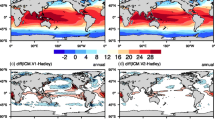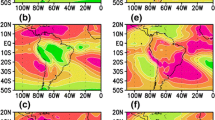Abstract
The characteristics of the El-Nino Southern Oscillation (ENSO) simulated in free integrations using two versions of the Seoul National University (SNU) ocean–atmosphere coupled global climate model (CGCM) are examined. A revised version of the SNU CGCM is developed by incorporating a reduced air–sea coupling interval (from 1 day to 2 h), a parameterization for cumulus momentum transport, a minimum entrainment rate threshold for convective plumes, and a shortened auto-conversion time scale of cloud water to raindrops. With the revised physical processes, lower tropospheric zonal wind anomalies associated with the ENSO-related sea surface temperature anomalies (SSTA) are represented with more realism than those in the original version. From too weak, the standard deviation of SST over the eastern Pacific becomes too strong in the revised version due to the enhanced air–sea coupling strength and intraseasonal variability associated with ENSO. From the oceanic side, the stronger stratification and the shallower-than-observed thermocline over the eastern Pacific also contribute to the excessive ENSO. The impacts of the revised physical processes on the seasonal predictability are investigated in two sets of the hindcast experiment performed using the two versions of CGCMs. The prediction skill measured by anomaly correlation coefficients of monthly-mean SSTA shows that the new version has a higher skill over the tropical Pacific regions compared to the old version. The better atmospheric responses to the ENSO-related SSTA in the revised version lead to the basin-wide SSTA maintained and developed in a manner that is closer to observations. The symptom of an excessively strong ENSO of the new version in the free integration is not prominent in the hindcast experiment because the thermocline depth over the eastern Pacific is maintained as initialized over the arc of time of the hindcast (7 months).















Similar content being viewed by others
References
AchutaRao K, Sperber K (2002) Simulation of the El Niño Southern Oscillation: results from the coupled model intercomparison project. Clim Dyn 19:191–209. doi:10.1007/s00382-001-0221-9
AchutaRao K, Sperber K (2006) ENSO simulation in coupled ocean-atmosphere models: are the current models better? Clim Dyn 27:1–15. doi:10.1007/s00382-006-0119-7
An S-I, Jin F-F (2001) Collective role of thermocline and zonal advective feedbacks in the ENSO mode*. J Clim 14:3421–3432
An S-I, Wang B (2000) Interdecadal change of the structure of the ENSO mode and its impact on the ENSO frequency. J Clim 13:2044–2055
An S-I, Jin F-F, Kang I-S (1999) The role of zonal advection feedback in phase transition and growth of ENSO in the Cane–Zebiak model. J Meteor Soc Jpn 77:1151–1160
An S-I, Kug J-S, Ham Y-G, Kang I-S (2008) Successive modulation of ENSO to the future greenhouse warming. J Clim 21:3–21
Barnston AG, He Y, Michael HG (1999) Predictive skill of statistical and dynamical climate models in SST forecasts during the 1997–98 El Niño Episode and the 1998 La Niña Onset. Bull Am Meteor Soc 80:217–243
Behringer DW, Xue Y (2004) Evaluation of the global ocean data assimilation system at NCEP: The Pacific Ocean. In: Eighth symposium on integrated observing and assimilation systems for atmosphere, ocean and land surface, AMS 84th annual meeting, Washington State Convention and Trade Center, Seattle, Washington, pp 11–15
Bejarano J, Jin F-F (2006) Coexistence of equatorial coupled modes of ENSO. J Clim 21:3051–3067
Bonan GB (1996) A land surface model (LSM version 1.0) for ecological, hydrological, and atmospheric studies: technical description and user’s guide. NCAR Techical Note NCAR/TN-417 + STR, National Center For Atmospheric Research Boulder, Colorado, pp 1–150
Cane MA, Munnich M, Zebiak SE (1990) A study of self-excited oscillations of the tropical ocean–atmosphere system. Part I: Linear analysis. J Atmos Sci 47:1562–1577
Danabasoglu G, Large WG, Tribbia JJ, Gent PR, Briegleb BP, McWilliams JC (2006) Diurnal coupling in the tropical oceans of CCSM3. J Clim 19:2347–2365
Davey M, Huddleston M, Sperber K, Braconnot P, Bryan F, Chen D, Colman R, Cooper C, Cubasch U, Delecluse P et al (2002) STOIC: a study of coupled model climatology and variability in tropical ocean regions. Clim Dyn 18:403–420. doi:10.1007/s00382-001-0188-6
Guilyardi E et al (2009a) Understanding El Niño in ocean-atmosphere general circulation models: progress and challenges. Bull Am Meteor Soc 90:325–340
Guilyardi E, Braconnot P, Jin F-F, Kim ST, Kolasinski M, Li T, Musat I (2009b) Atmosphere feedbacks during ENSO in a coupled GCM with a modified atmospheric convection scheme. J Clim 22:5698–5718
Ham Y-G, Kug J-S, Kang I-S, Jin F-F, Timmermann A (2009) Impact of diurnal atmosphere-ocean coupling on tropical climate simulations using a coupled GCM. Clim Dyn 34, doi:10.1007/s00382-009-0586-8
Hayes SP, Mangum’ LJ, PiCaut J, Sumi A, Takeuchi K (1991) TOGA-TAO: a moored array for real-time measurements in the tropical pacific ocean. Bull Am Meteor Soc 72:339–347
Hoffman RN, Kalnay E (1983) Lagged averaged forecasting, an alternative to Monte Carlo forecasting. Tellus 35A:100–118
Holtslag AAM, Boville BA (1993) Local versus nonlocal boundary layer diffusion in a global climate model. J Clim 6:1642–1825
Jin F-F (1997) An equatorial ocean recharge paradigm for ENSO. Part I: Conceptual model. J Atmos Sci 54:811–829
Jin F-F, An S-I (1999) Thermocline and zonal advective feedbacks within the equatorial ocean recharge oscillator model for ENSO. Geophys Res Lett 26(19):2989–2992, doi:10.1029/1999GL002297
Jin EK, Kinter JL, Wang B, Park C-K, Kang I-S, Kirtman BP, Kug J-S, Kumar A, Luo J-J, Schemm J et al (2008) Current status of ENSO prediction skill in coupled ocean–atmosphere models. Clim Dyn 31:647–664. doi:10.1007/s00382-008-0397-3
Kang I-S, Kug J-S (2002) El Nino and La Nina sea surface temperature anomalies: asymmetry characteristics associated with their wind stress anomalies. J Geophys Res 107(D19):4372
Kessler WS, Kleeman R (2000) Rectification of the Madden–Julian Oscillation into the ENSO Cycle. J Clim 13:3560–3575
Kim D, Kug J-S, Kang I-S, Jin F-F, Wittenberg A (2008) Tropical Pacific impacts of convective momentum transport in the SNU coupled GCM. Clim Dyn 31, doi:10.1007/s00382-007-0348-4
Kirtman BP (1997) Oceanic Rossby wave dynamics and the ENSO period in a coupled model. J Clim 10:1690–1704
Kirtman BP, Shukla J, Balmaseda M, Graham N, Penland C, Xue Y, Zebiak SE (2001) Current status of ENSO forecast skill: A report to the Climate Variability and Predictability (CLIVAR) Working Group on Seasonal to Interannual Prediction. WCRP Informal Report No 23/01, p. 31
Kug J-S, Kang I-S, An S-I (2003) Symmetric and antisymmetric mass exchanges between the equatorial and off-equatorial Pacific associated with ENSO. J Geophys Res 108(C8):3284
Kug J-S, Kang I-S, Choi D-H (2008) Seasonal climate predictability with Tier-one and Tier-two prediction systems. Clim Dyn 31, doi:10.1007/s00382-007-0264-7
Kug J-S, Choi J, An S-I, Jin F-F, Wittenberg AT (2010) Warm pool and cold tongue El Nino events as simulated by the GFDL 2.1 coupled GCM. J Clim 23:1226–1239
Large WG, Gent PR (1999) Validation of vertical mixing in an equatorial ocean model using large eddy simulations and observations. J Phys Oceanogr 29:449–464
Latif M, Sperber K, Arblaster J, Braconnot P, Chen D, Colman A, Cubasch U, Cooper C, Delecluse P, Dewitt D et al (2001) ENSIP: the El Niño simulation intercomparison project. Clim Dyn 18:255–276. doi:10.1007/s003820100174
Le Treut H, Li Z-X (1991) Sensitivity of an atmospheric general circulation model to prescribed SST changes: feedback effects associated with the simulation of cloud optical properties. Clim Dyn 5:175–187
Lee M-I, Kang I-S, Kim J-K, Mapes BE (2001) Influence of cloud-radiation interaction on simulating tropical intraseasonal oscillation with an atmospheric general circulation model. J Geophys Res 106:14219–14233
Lee M-I, Kang I-S, Mapes BE (2003) Impacts of cumulus convection parameterization on aqua-planet AGCM simulations of tropical intraseasonal variability. J Meteor Soc Jpn 81:963–992
Lin J-L (2007) The double-ITCZ problem in IPCC AR4 coupled GCMs: ocean–atmosphere feedback analysis. J Clim 20:4497–4525
Lin J-L, Lee M-I, Kim D, Kang I-S, Frierson DMW (2008) The impacts of convective parameterization and moisture triggering on AGCM-simulated convectively coupled equatorial waves. J Clim 21:883–909
Luo J-J, Masson S, Behera S, Shingu S, Yamagata T (2005) Seasonal climate predictability in a coupled OAGCM using a different approach for ensemble forecasts. J Clim 18:4474–4497
McPhaden MJ (1999) Genesis and evolution of the 1997–98 El Nin˜o. Science 283:950–954
McPhaden MJ (2002) Mixed layer temperature balance on intraseasonal timescales in the Equatorial Pacific Ocean*. J Clim 15:2632–2647
McPhaden MJ, Taft BA (1988) Dynamics of seasonal and intraseasonal variability in the Eastern Equatorial Pacific. J Phys Oceanogr 18:1713–1732
Nakajima T, Tsukamoto M, Tsushima Y, Numaguti A (1995) Modelling of the radiative processes in an AGCM. In: Matsuno T (ed) Climate system dynamics and modelling, vol 1–3. University of Tokyo, Tokyo, pp 104–123
Neale RB, Richter JH, Jochum M (2008) The impact of convection on ENSO: from a delayed oscillator to a series of events. J Clim 21:5904–5924
Noh Y, Kim HJ (1999) Simulations of temperature and turbulence structure of the oceanic boundary layer with the improved near-surface process. J Geophys Res 104:15621–15634
Numaguti A, Takahashi M, Nakajima T, Sumi A (1995) Development of an atmospheric general circulation model. In: Matsuno T (ed) Climate system dynamics and modelling. Univrsity of Tokyo, Tokyo, vol I–3, pp 1–27
Seiki A, Takayabu YN (2007) Westerly wind bursts and their relationship with intraseasonal variations and ENSO. Part I: statistics. Mon Weather Rev 135:3325–3345
Smith T, Reynolds R (2004) Improved extended reconstruction of SST (1854–1997). J Clim 17:2466–2477
Sooraj KP, Kim D, Kug J-S, Yeh S-W, Jin F-F, Kang I-S (2008) Effects of the low frequency zonal wind variation on the high frequency atmospheric variability over the tropics. Clim Dyn 33:496–507. doi:10.1007/s00382-008-0483-6
Tiedtke M (1983) The sensitivity of the time-mean large-scale flow to cumulus convection in the ECMWF model. Workshop on Convection in large-scale numerical models. ECMWF, 28 Nov–1 Dec 1983, pp 297–316
Tokioka T, Yamazaki K, Kitoh A, Ose T (1988) The equatorial 30–60 day oscillation and the Arakawa-Schubert penetrative cumulus parameterization. J Meteor Soc Jpn 66:883–901
Uppala SM et al (2005) The ERA-40 re-analysis. Quart J R Meteorol Soc 131:2961–3012. doi:10.1256/qj.04.176
Vecchi GA, Harrison DE (2000) Tropical Pacific Sea surface temperature anomalies, El Niño, and Equatorial Westerly Wind Events*. J Clim 13:1814–1830
Wang B, Lee J-Y, Kang I-S, Shukla J, Park C-K, Kumar A, Schemm J, Cocke S, Kug J-S, Luo J-J et al (2009) Advance and prospectus of seasonal prediction: assessment of the APCC/CliPAS 14-model ensemble retrospective seasonal prediction (1980–2004). Clim Dyn 33:93–117. doi:10.1007/s00382-008-0460-0
Wittenberg AT, Rosati A, Lau NC, Ploshay JJ (2006) GFDL’s CM2 global coupled climate models. Part III: Tropical pacific climate and ENSO. J Clim 19:698–722
Wu X, Grabowski WW, Moncrieff MW (1998) Long-term behavior of cloud systems in TOGA COARE and their interactions with radiative and surface processes. Part I: Two-dimensional modeling study. J Atmos Sci 55:2693–2714
Wu X, Deng L, Song X, Vettoretti G, Peltier WR, Zhang GJ (2007) Impact of a modified convective scheme on the Madden-Julian Oscillation and El Niño-Southern Oscillation in a coupled climate model. Geophys Res Lett 34:L16823
Xie P, Arkin PA (1997) Global precipitation: a 17-year monthly analysis based on gauge observations, satellite estimates, and numerical model outputs. Bull Am Meteor Soc 78:2539–2558
Yeh S-W, Kug J-S, Dewitte B, Kwon M-H, Kirtman B, Jin F-F (2009) El Niño in a changing climate. Nature 461:511–514
Zeng X, Zhao M, Dickinson RE (1998) Intercomparison of bulk aerodynamic algorithms for the computation of sea surface fluxes using TOGA COARE and TAO data. J Clim 11:2628–2644
Acknowledgments
ISK was supported by the National Research Foundation of Korea (NRF) Grant Funded by the Korean Government (MEST) (NRF-2009-C1AAA001-2009-0093042) and second phase of the Brain Korea 21. And, DK was supported by NASA grant NNX09AK34G.
Author information
Authors and Affiliations
Corresponding author
Rights and permissions
About this article
Cite this article
Ham, YG., Kang, IS., Kim, D. et al. El-Nino Southern Oscillation simulated and predicted in SNU coupled GCMs. Clim Dyn 38, 2227–2242 (2012). https://doi.org/10.1007/s00382-011-1171-5
Received:
Accepted:
Published:
Issue Date:
DOI: https://doi.org/10.1007/s00382-011-1171-5




